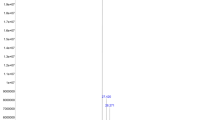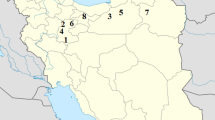Abstract
Myrtle, Myrtus communis L. (Myrtaceae), an evergreen shrub also known as wild myrtle, has a history of use as a culinary and medicinal plant. To determine the diversity within the species, plant leaves of myrtle were collected in 12 natural habitats in Iran for investigation of chemical constituents in the essential oil. Extraction of the essential oils produced yields ranging from 0.7 to 1.5 mL per 100 g dry tissue. An analysis of the oils by GC and GC/MS revealed 40 compounds, constituting 90.1–99.9 % of the essential oils. Chemical constituents varied with the site of sample origin, although the principal essential oil components from all populations, were α-pinene (17.5–37.1 %), 1,8-cineole (9.9–29.8 %), linalool (7.0–23.1 %), and α-terpineol (5.3–8.3 %). Limonene (tr, 22.7 %) was a major constituent in three populations. Characterized chemotypes included Chemotype I: α-pinene/1,8-cineole/linalool, Chemotype II: α-pinene/linalool, Chemotype III: α-pinene/1,8-cineole, and Chemotype IV: α-pinene/1,8-cineole/limonene. The main source of variability in chemical composition and oil yield appeared to be differences in environmental conditions and chemotypes as plant populations collected from close geographical areas could be classified in a cluster.



Similar content being viewed by others
References
Adams RP (2007) Identification of essential oil components by gas chromatography/quadrupole mass spectroscopy. Allured Publishing Corporation, Carol Stream
Aidi Wannes WA, Mhamdi B, Sriti J, Marzouk B (2010) Changes in essential oil composition of Tunisian Myrtus communis var. italica L. during its vegetative cycle. J Essent Oil Res 22:13–18
Asllani U (2000) Chemical composition of albanian myrtle oil (Myrtus communis L.). J Essent Oil Res 12:140–142
Atzei AD (2003) Le piante nella tradizione popolare della Sardegna. Carlo Delfino Editore, Sassari, pp 319–323
Bajalan I, Ghasemi Pirbalouti A (2014) Variation in antibacterial activity and chemical compositions of essential oil from different populations of myrtle. Ind Crop Prod 61:303–307
Barbosa P, Lima AS, Vieria P, Dias LS, Tinoco MT, Barroso JG, Pedro LG, Figueiredo AC, Mota M (2010) Nematicidal activity of essential oils and volatiles derived from Portuguese aromatic flora against the pinewood nematode, Bursaphelenchus xylophilus. J Nematol 42:8–16
Boelens MH, Jimenez R (1991) The chemical composition of Spanish myrtle leaf oils. Part I. J Essent Oil Res 3:173–177
Bradesi TP, Casanova J, Costa J, Bernardini AF (1997) Chemical composition of myrtle leaf oil from Corsica (France). J Essent Oil Res 9:283–288
Chalchat JC, Garry RP, Michet A (1998) Essential oil of Myrtle (Myrtus communis L.) of the Mediterranean Littoral. J Essent Oil Res 10:613–617
Council of Europe (1997) European Pharmacopoeia, 3rd edn. Council of Europe, Strasbourg, pp 121–122
Djenane D, Yangüela J, Amrouche T, Boubrit S, Boussad N, Roncalés P (2011) Chemical composition and antimicrobial effects of essential oils of Eucalyptus globulus, Myrtus communis and Satureja hortensis against Escherichia coli O157:H7 and Staphylococcus aureus in minced beef. Food Sci Technol Int 17:505–515
Elfellah MS, Akhter MH, Khan MT (1984) Anti-hyperglycaemic effect of an extract of Myrtus communis in streptozotocin induced diabetes in mice. J Ethnopharmacol 11:275–281
Farah A, Afifi A, Fechtal M, Chhen A, Satrani B, Talbi M, Chaouch A (2006) Fractional distillation effect on the chemical composition of Moroccan myrtle (Myrtus communis L.) essential oils. Flavour Frag J 21:351–354
Flamini G, Cioni PL, Morelli I, Maccioni S, Baldini R (2004) Phytochemical typologies in some populations of Myrtus communis L. on Caprione Promontory (East Liguria, Italy). Food Chem 85:599–604
Gardeli C, Vassiliki P, Athanasios M, Kibouris T, Komaitis M (2008) Essential oil composition of Pistacia lentiscus L. and Myrtus communis L.: evaluation of antioxidant capacity of methanolic extracts. Food Chem 107:1120–1130
Ghasemi Pirbalouti A (2009) Medicinal plants used in Chaharmahal and Bakhtyari districts, Iran. Herba Pol 55:69–75
Ghasemi Pirbalouti A, Mirbagheri H, Hamedi B, Rahimi E (2014) Antibacterial activity of the essential oils of myrtle leaves against Erysipelothrix rhusiopathiae. Asian Pac J Trop Biomed 4:505–509
Hayder N, Skandrani I, Kilani S, Bouhlel I, Abdelwahed A, Ben Ammar R, Mahmoud A, Ghedira K, Chekir-Ghedira L (2008) Antimutagenic activity of Myrtus communis L. using the Salmonella microsome assay. S Afr J Bot 74:121–125
Hendawy SF, Khalid KA (2005) Response of sage (Salvia officinalis L.) plants to zinc application under different salinity levels. J Appl Sci Res 1:147–155
Jerkovic I, Radonic A, Borcic I (2002) Comparative study of leaf, fruit and flower essential oils from Croatian Myrtus communis L. during a 1-year vegetative cycle. J Essent Oil Res 14:266–270
Lawrence BM (1996) Progress in essential oils. Myrtle oil Perfum Flavor 21:57–58
Levesque H, Lafont O (2000) Aspirin throughout the ages: a historical review. La Revue de Medecine Interne 21:8–17
Mahboubi M, Ghazian Bidgoli F (2010) In vitro synergistic efficacy of combination of amphotericin B with Myrtus communis essential oil against clinical isolates of Candida albicans. Phytomedicine 17:771–774
Messaoud C (2001) Polymorphisme isoenzymatique et variabilité de quelques constituants chimiques de l’huile essentielle chez le Myrte commun (Myrtus communis L.) en Tunisie. Mémoire de DEA, Facultédes Sciences Bizerte Tunisia, pp 80
Messaoud C, Zaouali Y, Salah AB, Khoudja ML, Boussaid M (2005) Myrtus communis in Tunisia: variability of the essential oil composition in natural populations. Flavour Fragr J 20:577–582
Messaoud C, Laabidi A, Boussaid M (2012) Myrtus communis L. infusions: the effect of infusion time on phytochemical composition, antioxidant, and antimicrobial activities. J Food Sci 77:941–947
Moore BD, Foley WJ, Wallis IR, Cowling A, Handasyde KA (2005) Eucalyptus foliar chemistry explains selective feeding by koalas. Biol Lett 1:64–67
Motazedian N, Ravan S, Bandani AR (2012) Toxicity and repellency effects of three essential oils against Tetranychus urticae Koch (Acari: Tetranychidae). J Agr Sci Tech 14:275–284
Mulas M, Melis RAM (2011) Essential oil composition of myrtle (Myrtus communis) leaves. J Herbs Spices Med Plants 17:21–34
Oka Y, Ben-Daniel B, Cohen Y (2012) Nematicidal activity of the leaf powder and extracts of Myrtus communis against the root-knot nematode Meloidogyne javanica. Plant Pathol 61:1012–1020
Ozek T, Demirci B, Baser KHC (2000) Chemical composition of Turkish myrtle oil. J Essent Oil Res 12:541–544
Pereira PC, Cebola MJ, Bernardo-Gil MG (2009) Evolution of the yields and composition of essential oil from Portuguese Myrtle (Myrtus comunis L.) through the vegetative cycle. Molecules 14:3094–3105
Pirbalouti AG (2010) Iranian Medicinal Plants (Introduction and Application), 2nd edn. I.A.U. Publisher, Shahrekord
Rasooli I, Moosavi ML, Rezaee MB, Jaimand K (2002) Susceptibility of microorganisms to Myrtus communis L. essential oil and its chemical composition. J Agric Sci Technol 4:127–133
Rossi A, Paola RD, Mazzon E, Genovese T, Caminiti R, Bramanti P, Pergola C, Koeberle A, Werz O, Sautebin L, Cuzzocrea S (2009) Myrtucommulone from Myrtus communis exhibits potent anti-inflammatory effectiveness in vivo. J Pharmacol Exp Ther 329:76–86
Sangwan NS, Farooqi AHA, Shabih F, Sangwan RS (2001) Regulation of essential oil production in plants. Plant Growth Regul 34:3–21
Selmar D, Kleinwächter M (2013) Influencing the product quality by deliberately applying drought stress during the cultivation of medicinal plants. Ind. Crop Prods 42:558–566
Semikolenov VA, Ilyna II, Simakova IL (2001) Linalool synthesis from α-pinene: kinetic peculiarities of catalytic steps. Appl Catal A 211:91–107
Tavassoli M, Shayeghi M, Abai MR, Vatandoost HV, Khoobdel M, Salari M, Ghaderi A, Rafi F (2011) Repellency effects of essential oils of myrtle (Myrtus communis), marigold (Calendula officinalis) compared with DEET against Anopheles stephensi on human volunteers. Iran J Arthropod-Borne Dis 5:10–22
Tuberoso CIG, Barra A, Angioni A, Sarritzu E, Pirisi FM (2006) Chemical composition of volatiles in Sardinian myrtle (Myrtus communis L.) alcoholic extracts and essential oils. J Agric Food Chem 54:1420–1426
Yadegarinia D, Gachkar L, Rezaei MB, Taghizadeh M, Alipoor Astaneh S, Rasooli I (2006) Biochemical activities of Iranian Mentha piperita L. and Myrtus communis L. essential oils. Phytochemistry 67:1249–1255
Zanetti S, Cannas S, Molicotti P, Bua A, Cubeddu M, Porcedda S, Marongiu B, Sechi LA (2010) Evaluation of the antimicrobial properties of the essential oil of Myrtus communis L. against clinical strains of Mycobacterium spp. Interdiscip Perspect Infect Dis 2010:1–3
Zargari A (1982–1992) Medicinal Plants, vol 1–6. University Publication, Tehran
Author information
Authors and Affiliations
Corresponding author
Additional information
Project funding: This work was supported by Deputy of Researches and Technology, Islamic Azad University of Shahrekord Branch, Iran (No Grant., IAUSHK-6121).
The online version is available at http://www.springerlink.com
Corresponding editor: Hu Yanbo
Rights and permissions
About this article
Cite this article
Ghasemi Pirbalouti, A., Craker, L.E. Diversity in chemical compositions of essential oil of myrtle leaves from various natural habitats in south and southwest Iran. J. For. Res. 26, 971–981 (2015). https://doi.org/10.1007/s11676-015-0094-0
Received:
Accepted:
Published:
Issue Date:
DOI: https://doi.org/10.1007/s11676-015-0094-0




